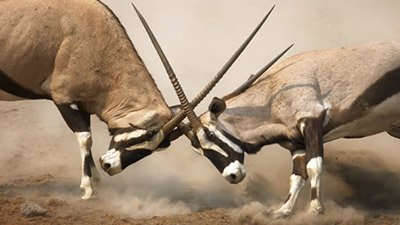
Survival of the Sniffer
Mammals grew bigger brains “the better to smell you, my dear!”
News Source
- Science: “Mammals’ Big Brains Began With a Sniff”
Paleontologists reporting in Science have concluded that it wasn’t survival of the smartest but survival of the sniffers that made larger brain size an evolutionary advantage. “Mammals didn’t get our larger brains for thinking,” says co-author Zhe-Xi Luo. “Our sense of smell was far more important.”
Using CT scans to trace the internal contours of skulls, a 3-D “virtual endocast” of each brain was simulated. The mammalian family tree was lined up to track evolutionary progress. First in line were the cynodonts—the reptile branch that presumably evolved into mammals while the dinosaurs were busy evolving into birds. Then came the two featured stars of the study: Morganucodon and Hadrocodium, thought by most evolutionists to be the earliest proto-mammals. Then came the skulls of “primitive” and modern mammals.
Compared to cynodonts, the Morganucodon’s brain appeared 50% larger, and the Hadrocodium’s, 50% larger than Morganucodon’s. The increase was primarily in the olfactory bulbs. (Of course, the relative brain to body size is in view here; otherwise, data ascribing the biggest proto-mammalian brain to the Hadrocodium, a creature weighing less than a paper-clip would be comical.) A better sense of smell presumably allowed proto-mammals to survive and reproduce, so that their descendants could eventually evolve into creatures with big enough brains to allow “full expression of a huge odorant receptor genome.”1
Liu’s study “provides the first evidence of the relative size of the brains and which parts were initially enlarging during critical stages in the evolution of modern mammalian brains,” says R. Glenn Northcutt, another endocast pioneer.2
The claim that mammals evolved from reptiles is primarily based on comparative jaw/ear anatomy. Evolutionists postulate that certain jaw bones in reptilian ancestors migrated over time to the middle ear of ancestral mammals. Dr. Luo’s work in this area has “literally altered science’s view of how mammals originated and evolved.”3 In 2001 his conclusions about Hadrocodium’s ear bones and jaw promoted that tiny creature to “closest known relative” of mammals. He concluded that the evolving big brain forced the ear bones apart.4 Apparently the Hadrocodium was using that brain to sniff out its world.
Descent from a common ancestor has never been observed. It is simply an interpretation of externally observed differences, based on an evolutionary world view.
The problem with lining up fossils and postulating that each transitioned into the next is that such comparisons focus on a limited number of features, such as jaws and ears. Such an approach ignores many other traits that would have to evolve to build a new class of animal. Close examination reveals that evolution of some characteristics seems at times to have reversed. And there are many unexplained gaps.
Furthermore, reptiles have no way to acquire the new information necessary to become mammals. Creatures with a well-developed sense of smell—those fully expressing their “huge odorant receptor genome”—might well have a survival advantage. But the fossil record has yet to produce any missing links. “[D]escent from a common ancestor has never been observed. It is simply an interpretation of externally observed differences, based on an evolutionary world view.”5
Further Reading
- Get Answers: Speciation
For More Information: Get Answers
Remember, if you see a news story that might merit some attention, let us know about it! (Note: if the story originates from the Associated Press, FOX News, MSNBC, the New York Times, or another major national media outlet, we will most likely have already heard about it.) And thanks to all of our readers who have submitted great news tips to us. If you didn’t catch all the latest News to Know, why not take a look to see what you’ve missed?
(Please note that links will take you directly to the source. Answers in Genesis is not responsible for content on the websites to which we refer. For more information, please see our Privacy Policy.)
Footnotes
- Timothy B. Rowe, Thomas E. Macrini, and Zhe-Xi Luo, “Fossil Evidence on Origin of the Mammalian Brain,” Science 332, no. 6032 (May 20, 2011): 955–957, doi:10.1126/science.1203117.
- R. Glenn Northcutt, “Evolving Large and Complex Brains,” Science 332, no. 6032 (May 20, 2011): 926–927, doi:10.1126/science.1206915.
- Betsy Momich, “Zhe-Xi Luo,” Carnegie Museums, 2010, http://www.carnegiemuseums.org/cmag/article.php?id=205.
- “Fossil Hints at Mammal Evolution,” BBC News, May 24, 2001, http://news.bbc.co.uk/2/hi/science/nature/1349763.stm.
- Mitchel Soltys, “Toward an Accurate Model of Variation in DNA,” Answers Research Journal 4 [(March 2, 2011): 11–23], 11, https://answersingenesis.org/genetics/dna-structure/toward-an-accurate-model-of-variation-in-dna/.
Recommended Resources

Answers in Genesis is an apologetics ministry, dedicated to helping Christians defend their faith and proclaim the good news of Jesus Christ.
- Customer Service 800.778.3390
- © 2024 Answers in Genesis






